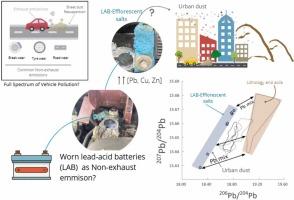废旧铅酸汽车电池产生的荧光盐是否代表潜在的非废气排放对城市污染?Pb同位素透视
IF 11.3
1区 环境科学与生态学
Q1 ENGINEERING, ENVIRONMENTAL
引用次数: 0
摘要
汽车铅酸电池已经使用了几十年,尽管替代电池技术的发展,它们仍然在世界范围内广泛使用,特别是在发展中国家。对铅酸蓄电池行业的生产、回收和环境影响进行了多项研究;然而,用于车辆运行的电池对城市污染(即非废气排放)的贡献仍未得到探索。磨损的铅酸电池会引发含有潜在有毒元素的荧光盐的形成,这些元素会沉淀在电池端子上,在车辆运输过程中可能会分散。本研究的重点是确定与这类荧光盐相关的铅的性质,以确定影响墨西哥西北部埃莫西约市城市尘埃中铅的来源。利用铅同位素系统学方法确定了城市扬尘组成的人为端元。荧光盐的铅同位素数据显示其放射性成分较少。这项研究的结果强调,与酸铅电池有关的荧光盐可能代表了与非废气排放相关的污染物的人为来源。荧光盐的贡献可能影响城市粉尘的铅同位素组成,并有助于了解非废气排放对城市粉尘的铅输入。本文章由计算机程序翻译,如有差异,请以英文原文为准。

Do efflorescent salts from worn lead-acid automotive batteries represent potential non-exhaust emissions to urban pollution? A Pb isotope perspective
Automotive lead-acid batteries have been used for decades, and despite the development of alternative battery technologies, they are still widely used around the world, especially in developing countries. Several studies on the production, recycling, and environmental impact of the lead-acid battery industry have been carried out; however, the contribution of batteries used in operating vehicles to urban pollution (i.e., non-exhaust emission) remains unexplored. Worn lead-acid batteries trigger the formation of efflorescent salts containing potentially toxic elements that precipitate on battery terminals, which could be dispersed during vehicle transport. This research focused on determining the nature of Pb associated with this type of efflorescent salts to identify the sources that influence Pb in the urban dust of Hermosillo city, northwestern Mexico. Pb isotope systematics was used to determine the anthropogenic end-member contributing to the composition of urban dust. Pb isotope data of efflorescent salts revealed less-radiogenic compositions. The findings of this research highlight that efflorescent salts related to acid-lead batteries may represent an anthropogenic source of contaminants associated with non-exhaust emissions. The contribution of efflorescent salts potentially influences the Pb isotope compositions of urban dust and may help to understand Pb inputs from non-exhaust emissions to urban dust.
求助全文
通过发布文献求助,成功后即可免费获取论文全文。
去求助
来源期刊

Journal of Hazardous Materials
工程技术-工程:环境
CiteScore
25.40
自引率
5.90%
发文量
3059
审稿时长
58 days
期刊介绍:
The Journal of Hazardous Materials serves as a global platform for promoting cutting-edge research in the field of Environmental Science and Engineering. Our publication features a wide range of articles, including full-length research papers, review articles, and perspectives, with the aim of enhancing our understanding of the dangers and risks associated with various materials concerning public health and the environment. It is important to note that the term "environmental contaminants" refers specifically to substances that pose hazardous effects through contamination, while excluding those that do not have such impacts on the environment or human health. Moreover, we emphasize the distinction between wastes and hazardous materials in order to provide further clarity on the scope of the journal. We have a keen interest in exploring specific compounds and microbial agents that have adverse effects on the environment.
 求助内容:
求助内容: 应助结果提醒方式:
应助结果提醒方式:


